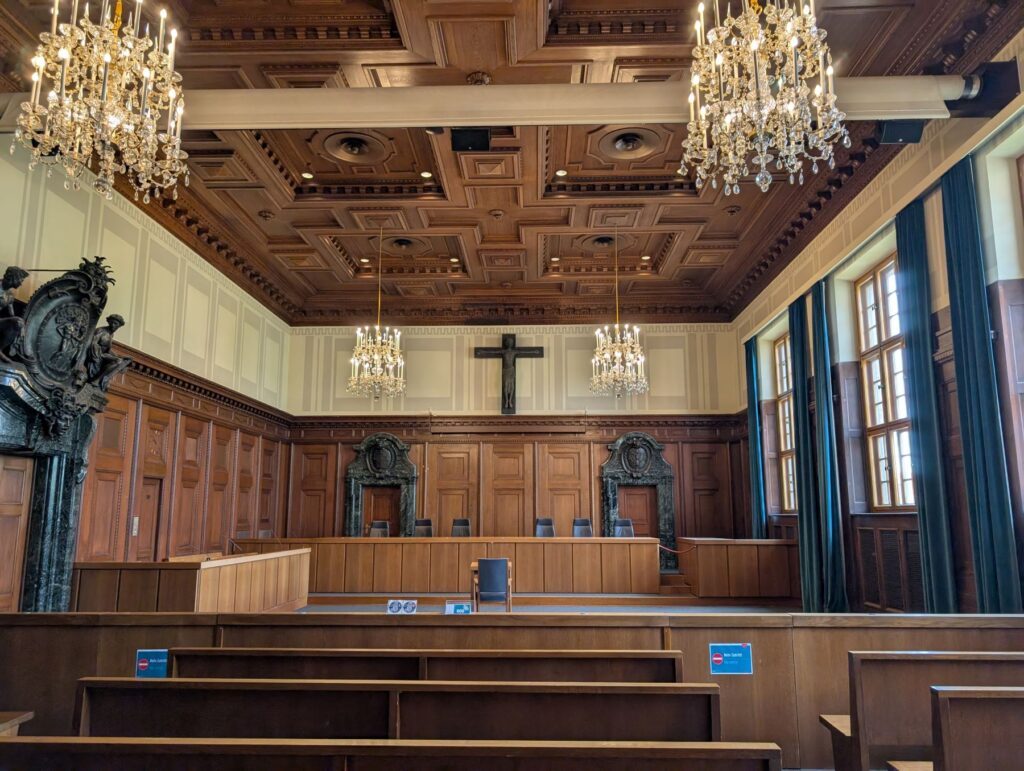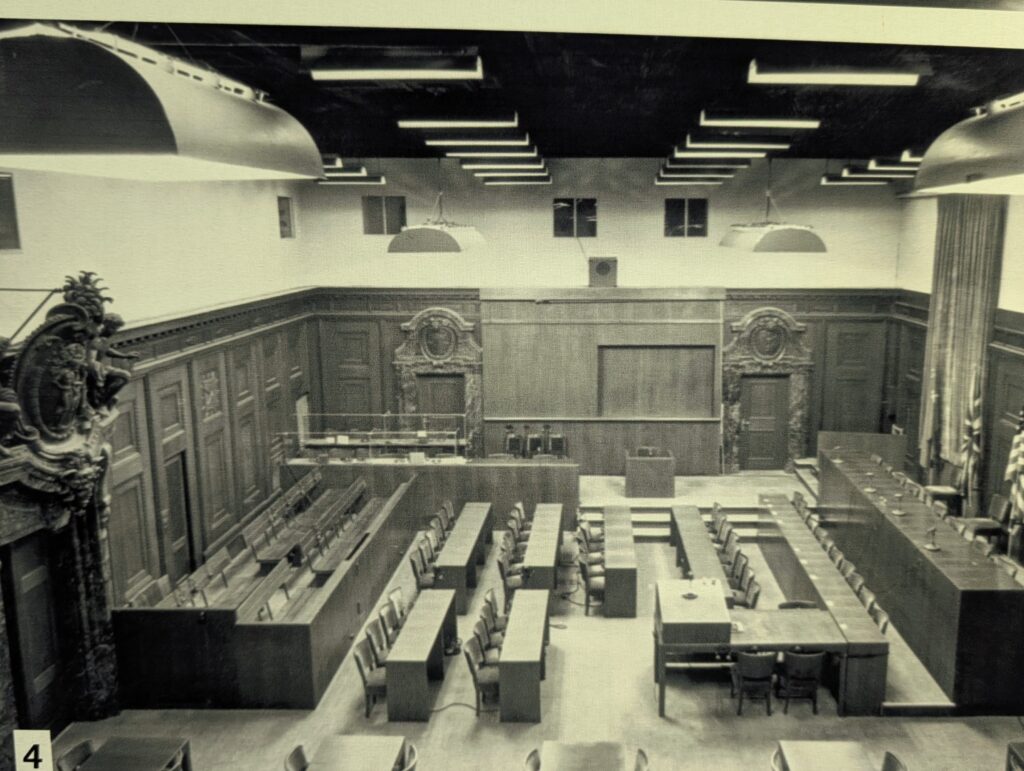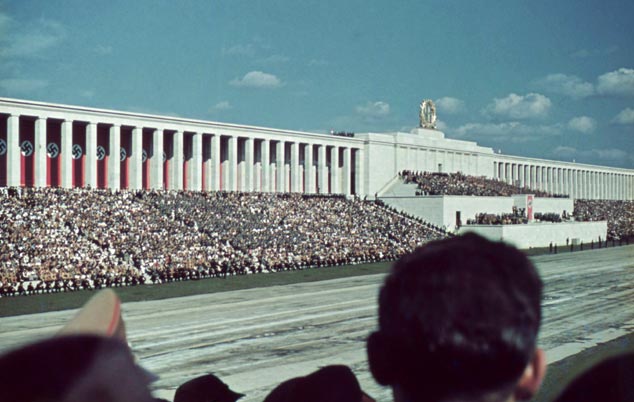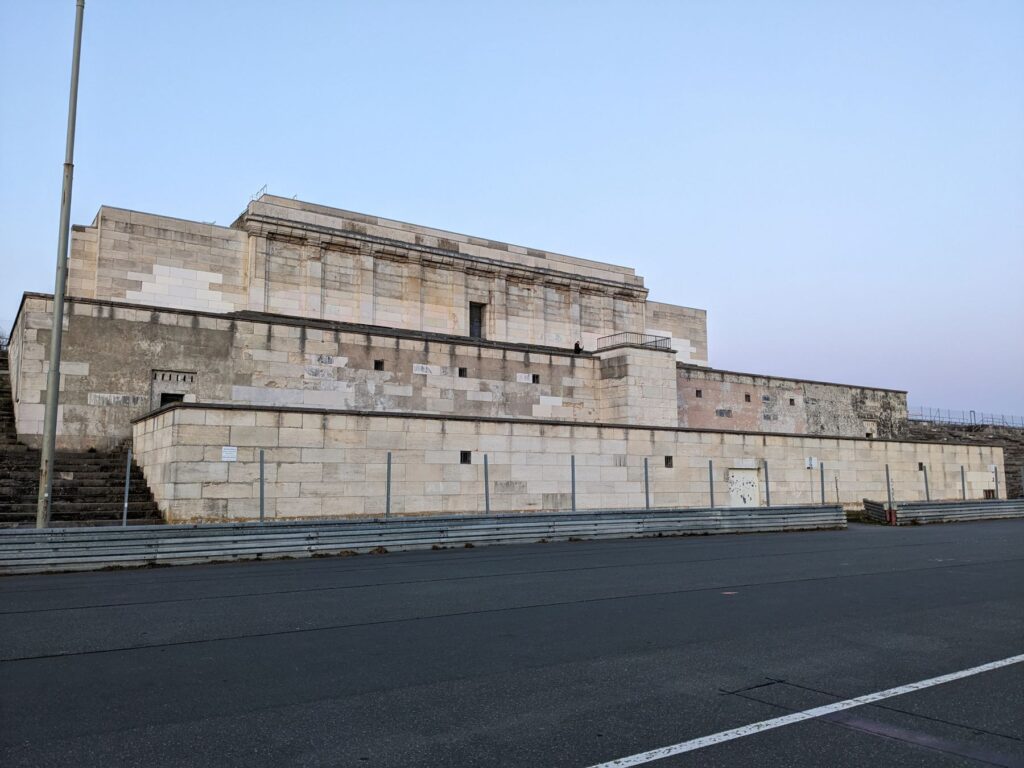Today is a very important day in the course of my trip. It’s D-Day. In the original draft of my itinerary for this trip, I had carefully plotted out a way to make it possible to be at the Normandy beaches today. Due to my grandparents’ plans and my desire to be with them, I had to take my trip in reverse order. It would’ve been fun to see the reenactors driving tanks and jeeps around Normandy, but I’m grateful to have taken the journey in the order that I did. I’m grateful that it put me where we are on this day. In some ways, it’s a little poetic. I get to be where the war in Europe was resolved on the day that the end of the Third Reich began.
The Nuremberg Trials
This morning, we had the opportunity to visit Courtroom 600 where the surviving leaders of the Nazi regime were tried before the eyes of the world. Prior to this trip, I knew very little about the trials other than the fact that several Nazi leaders were convicted and executed. Over the course of more than a dozen museums, I’ve learned quite a bit, which culminated today. I’ll share just a small portion of the revelations.

For starters, to most people, the idea of trying the Nazis in court seems a formality. Why bother? In the words of Winston Churchill:
Agree the trial will be a farce. Indictment: facilities for counsel. All sorts of complications ensue as soon as you admit a fair trial. I would take no responsibility for a trial – even though U.S. wants to do it. Execute the principal criminals as outlaws – if no Ally wants them.
According to the Nuremberg justice museum, it was the Americans that pushed for a legitimate trial, not only to save face and appear fair, but to set an important historical precedent for how war crimes should be approached in the future. As Chief Justice Robert Jackson put it in his opening statements:
“The privilege of opening the first trial in history for crimes against the peace of the world imposes a grave responsibility. The wrongs which we seek to condemn and punish have been so calculated, so malignant, and so devastating, that civilization cannot tolerate their being ignored, because it cannot survive their being repeated. That four great nations, flushed with victory and stung with injury stay the hand of vengeance and voluntarily submit their captive enemies to the judgment of the law is one of the most significant tributes that Power has ever paid to Reason.”
The Nuremberg Trials would take nearly 11 months to complete. In preparation, special teams from the Allied nations were sent to scavenge offices, cellars, caves, and anywhere else that there might be rumors of evidence of Nazi crimes. A sea of papers and hours of film were brought to the court to serve the purpose. One of the primary objectives of the trial was to highlight before the world irrefutable evidence of the atrocities the German nation committed. It was the first time that hard and graphic evidence of the Holocaust was shown to the public, completely shocking the world.
Four charges were brought in varying combinations before the defendants: (1) common plan and conspiracy, (2) crimes against peace, (3) crimes against humanity, (4) and war crimes.
22 Nazis were given the opportunity to make a defense case, either representing themselves or having lawyers. Every one of them pleaded not guilty. The primary defense argument was that they were “just following orders”. Despite being limited in their ability to prepare, defendants did argue successfully in some cases. Dönitz, the German Navy Admiral, made the case that the Allies had used the same naval tactics he was being accused of; for his case, he was acquitted of those particular charges.
In the end, 12 execution sentences were declared and the remaining officials served varying prison sentences.

The trials set several important precedents for international justice. To name a few, they represented the ability for international justice to become an institution, they established processes that are still used today, they introduced live translation to the courts which greatly improved the judicial process, they established accountability for actions taken during war, and they showed that not even the very top of a nation is exempt from the responsibility for wrongs. The precedents from these Trials have been crucial for the last 80 years in bringing justice throughout the the world.
Interestingly, the trials were not noteworthy following their conclusion. It wasn’t until the 1990s that great reflection was given and they became an important part of the legacy of WWII. In many ways, the Trials represent the end of the war, at least for Europe. Though still controversial in many areas, justice was brought fairly to the perpetrators of evil before the world. It’s a legacy we must keep moving forward to maintain the global peace that no other generations in human history have enjoyed.
The Art Bunker
Yesterday, I talked about the vast tunnel network under Nuremberg that was built as beer cellars. Leading up to WWII, one of the disconnected beer cellars was repurposed to serve as an art vault to protect famous art from bombings. Valerie and I had the opportunity to tour that bunker today.
We learned that as soon as the Nazi Party came to power, they had been planning war. Their preparations for the war began immediately. By the time WWII began, the Art Bunker had been completed and was already being filled with famous paintings, sculptures, crown jewels, and other important artifacts. The bunker was highly insulated from water, debris, and looters. After the war, the Monuments Men from the American army discovered the bunker and redistributed the art to its former homes.
In addition to the bunker itself, the Germans took great efforts to protect architectural art around the city. In each of the cathedrals, an important piece was either encased in concrete and sand or removed in preparation for Allied bombings. These proved to be good decisions, as a horrible bombing raid on January 2, 1944 reduced the entire city of Nuremberg to rubble. Over 90% of the buildings were damaged or destroyed. Yet, the important church pieces remained. Although the theft and hiding of art from around Europe was yet another crime of the Nazis, it’s perhaps one with the best outcome, as much of the art that was stolen and hidden away remained protected from the destruction that faced most of the continent.
The Rally Grounds
Unfortunately, we weren’t able to see the Nazi Rally Grounds due to a festival this week. On my last trip however, I was able to visit these locations. I thought it worth mentioning solely because Nuremberg is a city with a very rich medieval and symbolic history. For this reason, Hitler chose the city as the home city of Nazism. Several architectural projects were started here and the annual party rally was held in the city. In some ways, this city was the birthplace of the Nazi party and their propaganda. This is why the Allies chose to hold the trials here at the end of the war. From a certain point of view, this is where it all began and where it would end for Germany.


Tomorrow
Tomorrow we travel to Berlin. We might pop into a museum in the morning and perhaps one in Berlin too. I’m a little nervous — we’re doing a homestay for the next two nights. I hope it goes well!